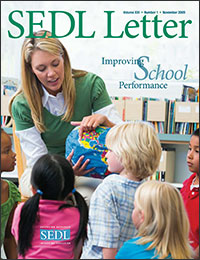SEDL Letter Volume XXI, Number 1: Improving School Performance

Authors: Laura Shankland (editor), Joni Wackwitz (editor), Ada Muoneke, Geoffrey Alan, D'Ette Cowan, Chris Times, Jackie Burniske
| Price: Available free online |
Available online: Full text, PDF
![]()
School improvement isn’t just about schools. It’s also about students and teachers, and how education leaders at all levels—state, district, school, and classroom—work together to help students succeed.
This issue of SEDL Letter explores school improvement in a variety of areas. The first story, “Imagining the Possibilities” describes the beginning of SEDL’s 4-year randomized controlled trial study of the Imagine It! reading program. Our research update then looks at recent research reports on an emerging trend for boosting achievement in low-performing schools: school turnarounds.
In “Uncharted Territory,” we examine how a growing number of high schools are using Response to Intervention as a framework for promoting student achievement. We have devoted two articles to SEDL’s Professional Teaching and Learning Cycle (PTLC), a professional development process in which teachers collaboratively plan and implement lessons aligned to their state standards. The first article, “Recovery 101,” describes how SEDL is helping Georgetown County School District in South Carolina implement the PTLC—an investment of federal stimulus dollars that can be sustained after the funding ends. Complementing this story is “Creating a Community of Professional Learners,” a more detailed overview of the PTLC and what it looks like in action.
We also look at the different ways that SEDL is supporting school improvement in Louisiana and Texas. “Building Bright Futures for Preschoolers in Madison Parish” looks at the Early Reading First project in Madison Parish, Louisiana. “Helping Texas Teachers Support English Language Learners” outlines how SEDL’s Texas Comprehensive Center is working with the Texas Education Agency to help teachers meet the instructional needs of English language learners. Although these two articles focus on different aspects of improving teaching, they both stress the importance of professional development and adapting instruction to meet students’ needs.
